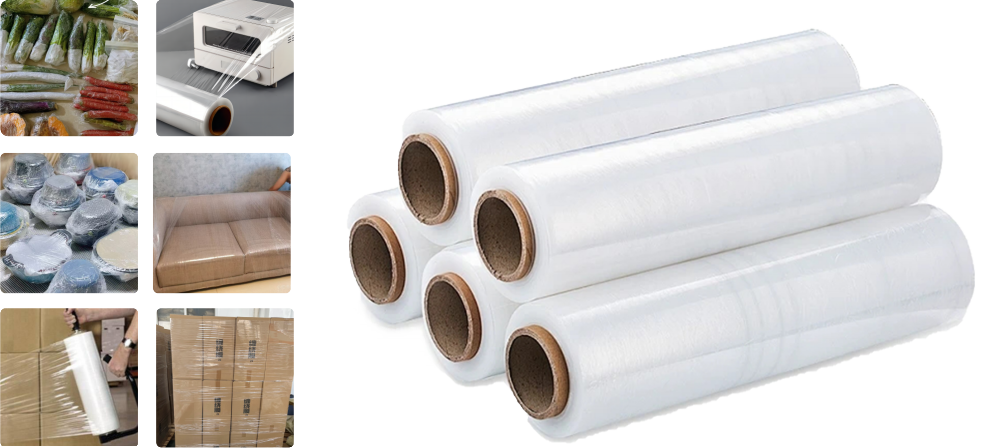02
2025
-
04
Product Introduction - Stretch Film
Author:
Inner membrane

I. Product Definition
Stretch film, also known as cling film, is a plastic film with high tensile strength and retractability. It is mainly used for cargo packaging and pallet wrapping, tightly wrapping items together to prevent loosening, dust, moisture, or damage during transportation.
II. Product Advantages
High-strength protection: It has good puncture resistance and tear resistance, effectively preventing transportation damage.
Excellent tensile properties: It can significantly reduce film costs, using less material for the same packaging volume.
Good self-adhesiveness: Single-sided or double-sided self-adhesive, no tape or heat sealing required, easy to use.
High transparency: Convenient for cargo identification and enhances packaging grade.
High-efficiency packaging: Compatible with automatic packaging machines, suitable for high-speed production lines.
Environmentally friendly and recyclable: Meets environmental protection requirements, recyclable, and energy-efficient.
III. Product Features
Features Description
Material Composition Mainly uses LLDPE (linear low-density polyethylene) as the base material, partially adding LDPE 、 mLLDPE etc.
Elongation Ratio Usually 300%-500% Special films can reach 600% even higher
Self-adhesive Method Single-sided self-adhesive / Double-sided self-adhesive
Processing Method Blown Film Blown Film ) / Cast Film Cast Film )
Color Options Transparent, black, blue, green, etc., customizable
Core Type Paper core / Plastic core, customizable inner diameter
IV. Technical Parameters (Reference Values)
Item Parameter Range
Thickness 10 μ m ~ 35 μ m
Width 300mm ~ 1500mm
Tensile Strength ≥ 25 MPa
Elongation ≥ 350%
Tear Strength ≥ 100 N/mm
Peel Strength (Self-adhesiveness) ≥ 1.0 N/cm
Roll Length 100m ~ 3000m (Customizable)
Storage Period 6 Months ~ 12 Months (Store at room temperature, away from light)
V. Application Range
Logistics and warehousing: Pallet packaging, cargo bundling, and container transportation, improving stability and safety.
Food and beverages: Bottled water, canned food outer wrapping, dust and moisture proof.
Electronics and electrical appliances: Packaging of home appliances, computers, printers, etc., to prevent scratches and shocks.
Building materials and chemicals: Bundling and packaging of bricks, barrels, plastic pipes, and other irregularly shaped objects.
Industrial manufacturing: Protection during long-distance transportation of machinery and equipment, and components.
E-commerce express delivery: Packaging reinforcement, reducing damage and loss during transportation.
VI. Production Process
1. Raw material preparation
Select high-quality LLDPE and auxiliary agents (antioxidants, adhesives, etc.).
2. Melt extrusion
Melt the raw materials using a single-screw or twin-screw extruder.
3. Film forming method:
Cast Film Cast Film ): Uniform film forming, high transparency, suitable for automatic packaging;
Blown Film Blown Film ): Strong toughness, good puncture resistance, suitable for heavy cargo.
4. Cooling and traction
Rapidly cool the film material to maintain its thickness and physical properties.
5. Slitting and rewinding
Slit into smaller rolls of different widths or lengths according to customer requirements.
6. Quality inspection
Conduct tensile testing, thickness testing, self-adhesiveness testing, haze and transparency testing.
VII. Market Competitive Advantages
Bulk staple products: covering all industrial, logistics, and e-commerce industries, with a huge market capacity.
Automated production adaptation: widely adaptable to automatic wrapping machines and high-speed assembly line packaging equipment.
Favorable environmental policies: recyclable packaging materials are supported by policies globally.
Transportation cost savings: small volume, light weight, easy to stack and transport.
Differentiated customization capabilities: such as high-end products like UV-resistant, anti-static, biodegradable films, and colored films.
VIII. Future Development Trends
Innovation in high-performance materials: such as nano-enhanced films and co-extruded multilayer films, to improve tensile ratio and durability.
Biodegradation and environmental protection: development of PLA 、 PBAT and other biodegradable materials, responding to the global environmental trend.
Smart packaging development: integrating QR codes, RFID chips and other information technologies to achieve intelligent tracking.
Automated adaptation upgrades: evolving towards higher speed, higher efficiency, and lower manpower packaging methods.
Ultra-thin development: reducing film thickness without compromising performance, lowering costs and carbon emissions.
International market expansion: emerging markets such as Southeast Asia, Africa, and the Middle East have huge potential, with manufacturing upgrades driving demand.
Latest News
2025-05-30
Chinaflilm Group's 12.91MW distributed photovoltaic power generation project successfully connected to the grid
The 12.91MW distributed photovoltaic power generation project, started on April 16, was completed in just 43 days, demonstrating "sunshine speed." Installed on factory rooftops, the project will significantly reduce carbon emissions and help the group achieve its green energy transformation.
2025-05-29
Chinafilm Group's distributed photovoltaic power generation project successfully connected to the grid, promoting green transformation of production
On May 29, 2025, Chinafilm Group reached a significant milestone—its 12.91398MW distributed photovoltaic power generation project was officially connected to the grid. The successful implementation of this project not only brought economic benefits to the company but also substantially benefited the power supply for production in its various projects.
2025-05-22
Application of scratch-resistant pre-coated films
Application of scratch-resistant pre-coated films
2025-04-15
Chinafilm Group's 12.91MW distributed photovoltaic project officially starts!
On April 15, 2025, Chongqing Chinafilm Technology Group Co., Ltd. (hereinafter referred to as "Chinafilm Group") and Sunshine New Energy Company jointly held a groundbreaking ceremony for a 12.91MW distributed photovoltaic power generation project in Chongqing. This marks the official launch of Chinafilm Group's important layout in the field of green energy and demonstrates the company's firm determination in sustainable development.
2025-04-14
The "Hardcore" Technology of Special Films: An In-depth Analysis of the Core Processes of High-Performance Film Materials
In modern industrial systems, thin-film materials have evolved from their traditional role of simple packaging into an advanced material system integrating functionality, structure, and intelligence. Special films, as the "high-end players" in the film family, are not only making great contributions in fields such as food, medicine, electronics, and automobiles, but also playing an irreplaceable role in the revolution of new material technologies.

